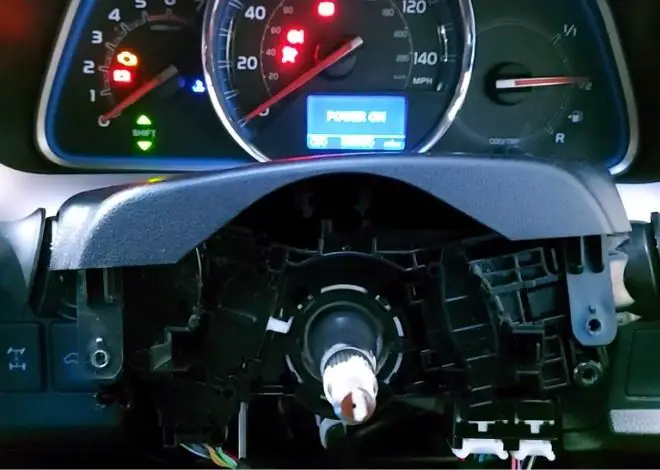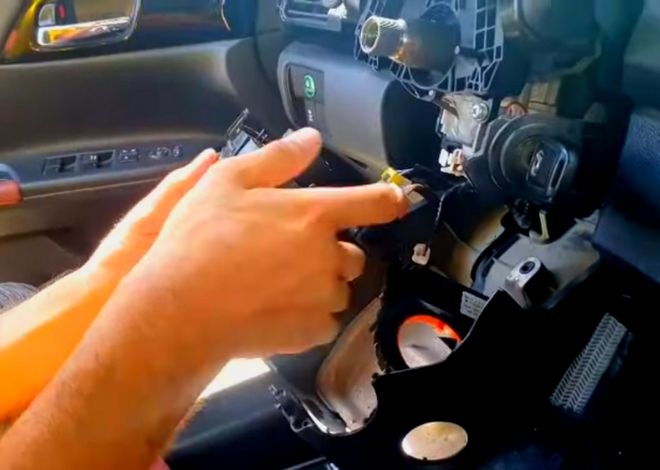Last Updated on May 6, 2025
Understanding and Resolving OBD-II Code U0126: Lost Communication with Steering Angle Sensor Module
When your vehicle’s OBD-II scanner displays Code U0126, it signifies a loss of communication with the Steering Angle Sensor (SAS) module. This issue can compromise critical systems like Electronic Stability Control (ESC), Anti-lock Braking System (ABS), and Electric Power Steering (EPS), affecting vehicle safety and handling. Prompt diagnosis and repair are essential to maintain optimal driving performance.
What Does Code U0126 Mean?
Code U0126 indicates that the SAS module is not transmitting or receiving messages via the Controller Area Network (CAN) bus. The SAS monitors the steering wheel’s position and communicates this data to other control modules, ensuring coordinated operation of systems like ESC and ABS.
Symptoms of Code U0126
Common indicators of this fault include:
- Illuminated Check Engine Light
- ABS, TRAC, or ESC warning lights activated
- Difficulty or stiffness when turning the steering wheel
- Intermittent or complete loss of power steering assistance
- Vehicle entering “limp” mode to prevent further damage
Common Causes of Code U0126
Several factors can trigger this error code:
- Dead or weak battery, leading to insufficient power supply
- Faulty SAS module or its integrated control unit
- Damaged wiring or poor connections in the CAN bus network
- Corroded or loose electrical connectors
- Short circuits or open circuits within the CAN bus lines
Diagnosing Code U0126: Step-by-Step Process
Accurate diagnosis is crucial to resolving OBD-II Code U0126, which points to a loss of communication between the Steering Angle Sensor (SAS) and the CAN (Controller Area Network) bus system. Here’s a systematic approach to identifying the root cause:

1. Scan for Additional Trouble Codes
Start with a high-quality OBD-II scanner and check if other Diagnostic Trouble Codes (DTCs) accompany U0126. Codes like U0100, U0140, or C1231 may suggest broader communication failures. If these are present, your issue may not be isolated to the SAS.
2. Inspect Battery Condition and Voltage
A weak or failing battery is one of the most common culprits behind communication errors. Measure battery voltage (should be 12.6V+ when idle) and test under load. Low voltage can disrupt the communication flow between modules on the CAN bus.
3. Perform a Visual Inspection of SAS Wiring and Connectors
Check all wiring harnesses, connectors, and ground points related to the SAS module. Look for:
- Corrosion (often green-tinted)
- Frayed or exposed wires
- Melted or burnt insulation
- Loose or dirty terminals
If any of these are found, they may be interrupting the data flow between the SAS and other control modules.
4. Check CAN Bus Communication Lines
Use a digital volt-ohmmeter (DVOM) or CAN tester to measure voltage on:
- CAN High (CAN C+): ~2.6V
- CAN Low (CAN C−): ~2.4V
Significant deviations or no fluctuation may indicate an open circuit, short to ground, or interference in the CAN network.
5. Test the Steering Angle Sensor (SAS) Module
Using a professional scan tool, attempt to communicate directly with the SAS module:
- If no communication is possible, the SAS module may be faulty or not powered.
- If communication is intermittent, suspect loose or weak connections or an unstable power supply.
6. Evaluate Grounding and Power Supply Circuits
Check the integrity of the SAS module’s ground and power sources. Ground resistance should be minimal. A voltage drop test can help verify if there’s resistance in the ground circuit.
Fixing Code U0126: Practical Repair Steps
Once you’ve diagnosed the issue, it’s time to fix the U0126 communication error. Here’s a detailed repair plan:

1. Reset and Recheck
After addressing any battery or connector-related issues, clear the code using your scan tool. Recheck the system by driving the vehicle. If the code doesn’t return, your issue was likely temporary or resolved.
2. Replace Damaged Wires or Connectors
If any wires are:
- Broken
- Pinched
- Corroded
- Burned
Replace or splice them properly with soldered joints and heat shrink tubing. For corroded terminals, clean them using electrical contact cleaner and a soft-bristle brush.
3. Replace the Steering Angle Sensor Module (if required)
If communication with the SAS module is not possible, or internal faults are detected, the module itself may be defective and should be replaced.
Tip: Always calibrate the new SAS module using a scan tool to ensure proper communication and alignment.
4. Update or Reprogram Control Modules
Some vehicles may require SAS firmware updates or ECU reprogramming. This can usually be done at a dealership or by a shop with OEM-level diagnostic equipment.
5. Reconnect and Test the CAN Bus Network
After repairs:
- Reconnect the negative battery cable
- Use your OBD-II tool to recheck the system
- Drive the vehicle under normal conditions
If U0126 doesn’t reappear, the issue is resolved.
6. Seek Professional Help if Necessary
If you’ve followed all steps and Code U0126 still returns, consult a certified technician. Advanced tools like oscilloscopes, CAN line sniffers, and SRS-specific scan tools may be required to pinpoint the fault.
Final Tip:
Never ignore U0126, especially if you notice issues with steering control. Since modern vehicles rely heavily on steering data for safety systems like ESC, ABS, and lane keep assist, resolving this error promptly ensures safe handling and peace of mind.
Importance of Addressing Code U0126
Neglecting this code can lead to compromised vehicle safety systems, including ESC and ABS, increasing the risk of accidents. Timely diagnosis and repair are crucial to maintain vehicle stability and steering responsiveness.
Frequently Asked Questions (FAQs) about U0126 Code
1. What does U0126 code mean on a car scanner?
Code U0126 means your vehicle’s system has lost communication with the Steering Angle Sensor (SAS) module. This sensor plays a vital role in stability, traction, and steering systems. When communication is lost, features like ESC or ABS may not function properly.
2. Can I still drive with the U0126 code active?
Technically, yes—but it is not recommended. Driving with this code can compromise your electronic power steering, traction control, and stability control, making the car harder to control in emergency situations. Fixing the issue as soon as possible is crucial for safety.
3. What causes the U0126 error code to appear?
Common causes include:
- A weak or dead battery
- Faulty SAS module
- Loose or corroded wiring/connectors
- CAN bus communication issues
- Open or short circuits in related systems
4. How much does it cost to fix Code U0126?
The repair cost varies based on the issue:
- Battery or wiring issues: $50–$200
- SAS module replacement: $200–$600+
- Professional diagnostics: $100–$150
Always get a diagnosis first to avoid unnecessary part replacements.
5. Do I need to reprogram the SAS module after replacement?
Yes. In most modern vehicles, after replacing the SAS module, calibration and reprogramming are required using a professional diagnostic tool. This ensures accurate data transmission and system functionality.
Conclusion: Don’t Ignore U0126—Act Quickly for Safety and Performance
The U0126 trouble code might seem minor, but it affects key systems that directly impact steering control, traction, and vehicle safety. Since modern vehicles rely on electronic communication between modules, any loss—especially in the Steering Angle Sensor—can result in a degraded driving experience and even dangerous handling.
By understanding what this code means, how to diagnose it, and how to fix it properly, you can avoid costly repairs and unsafe driving conditions. Whether it’s a simple wiring issue or a faulty module, taking timely action ensures your car performs at its best. If you’re unsure or unable to resolve the problem yourself, seek professional help to restore your vehicle’s full functionality.
Kevin Nicholas is an automotive technician who is a genius at software and hardware-related issues. He manually tested more than a hundred OBD scanners and gave his honest opinion on whether the device was worth the money or not. His in-depth OBD review articles help people choose the right product, whether it is a European, American, or Asian vehicle. He completed his Automotive Specialized Training Course at Universal Technical Institute and has more than 15 years of experience in the field.
